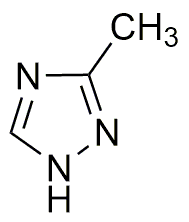3-Methyl-1H-1,2,4-triazole is widely utilized in research focused on:
- Agricultural Chemistry: This compound serves as a fungicide, effectively controlling various plant diseases. Its application helps in enhancing crop yield and quality, making it invaluable for farmers and agricultural researchers.
- Pharmaceutical Development: It is used in the synthesis of pharmaceutical intermediates, particularly in the development of antifungal medications. This application is crucial for researchers aiming to create effective treatments for fungal infections.
- Material Science: The compound is explored for its potential in creating advanced materials, such as polymers and coatings. Its unique properties can improve the durability and performance of these materials in various industrial applications.
- Analytical Chemistry: 3-Methyl-1H-1,2,4-triazole is employed in analytical methods to detect and quantify other chemical substances. This is particularly useful in quality control processes in laboratories and manufacturing.
- Environmental Science: It is studied for its role in bioremediation processes, helping to break down pollutants in soil and water. This application addresses environmental challenges and supports sustainability efforts.
General Information
Properties
Safety and Regulations
Applications
3-Methyl-1H-1,2,4-triazole is widely utilized in research focused on:
- Agricultural Chemistry: This compound serves as a fungicide, effectively controlling various plant diseases. Its application helps in enhancing crop yield and quality, making it invaluable for farmers and agricultural researchers.
- Pharmaceutical Development: It is used in the synthesis of pharmaceutical intermediates, particularly in the development of antifungal medications. This application is crucial for researchers aiming to create effective treatments for fungal infections.
- Material Science: The compound is explored for its potential in creating advanced materials, such as polymers and coatings. Its unique properties can improve the durability and performance of these materials in various industrial applications.
- Analytical Chemistry: 3-Methyl-1H-1,2,4-triazole is employed in analytical methods to detect and quantify other chemical substances. This is particularly useful in quality control processes in laboratories and manufacturing.
- Environmental Science: It is studied for its role in bioremediation processes, helping to break down pollutants in soil and water. This application addresses environmental challenges and supports sustainability efforts.
Documents
Safety Data Sheets (SDS)
The SDS provides comprehensive safety information on handling, storage, and disposal of the product.
Product Specification (PS)
The PS provides a comprehensive breakdown of the product’s properties, including chemical composition, physical state, purity, and storage requirements. It also details acceptable quality ranges and the product's intended applications.
Certificates of Analysis (COA)
Search for Certificates of Analysis (COA) by entering the products Lot Number. Lot and Batch Numbers can be found on a product’s label following the words ‘Lot’ or ‘Batch’.
*Catalog Number
*Lot Number
Certificates Of Origin (COO)
This COO confirms the country where the product was manufactured, and also details the materials and components used in it and whether it is derived from natural, synthetic, or other specific sources. This certificate may be required for customs, trade, and regulatory compliance.
*Catalog Number
*Lot Number
Safety Data Sheets (SDS)
The SDS provides comprehensive safety information on handling, storage, and disposal of the product.
DownloadProduct Specification (PS)
The PS provides a comprehensive breakdown of the product’s properties, including chemical composition, physical state, purity, and storage requirements. It also details acceptable quality ranges and the product's intended applications.
DownloadCertificates of Analysis (COA)
Search for Certificates of Analysis (COA) by entering the products Lot Number. Lot and Batch Numbers can be found on a product’s label following the words ‘Lot’ or ‘Batch’.
*Catalog Number
*Lot Number
Certificates Of Origin (COO)
This COO confirms the country where the product was manufactured, and also details the materials and components used in it and whether it is derived from natural, synthetic, or other specific sources. This certificate may be required for customs, trade, and regulatory compliance.


